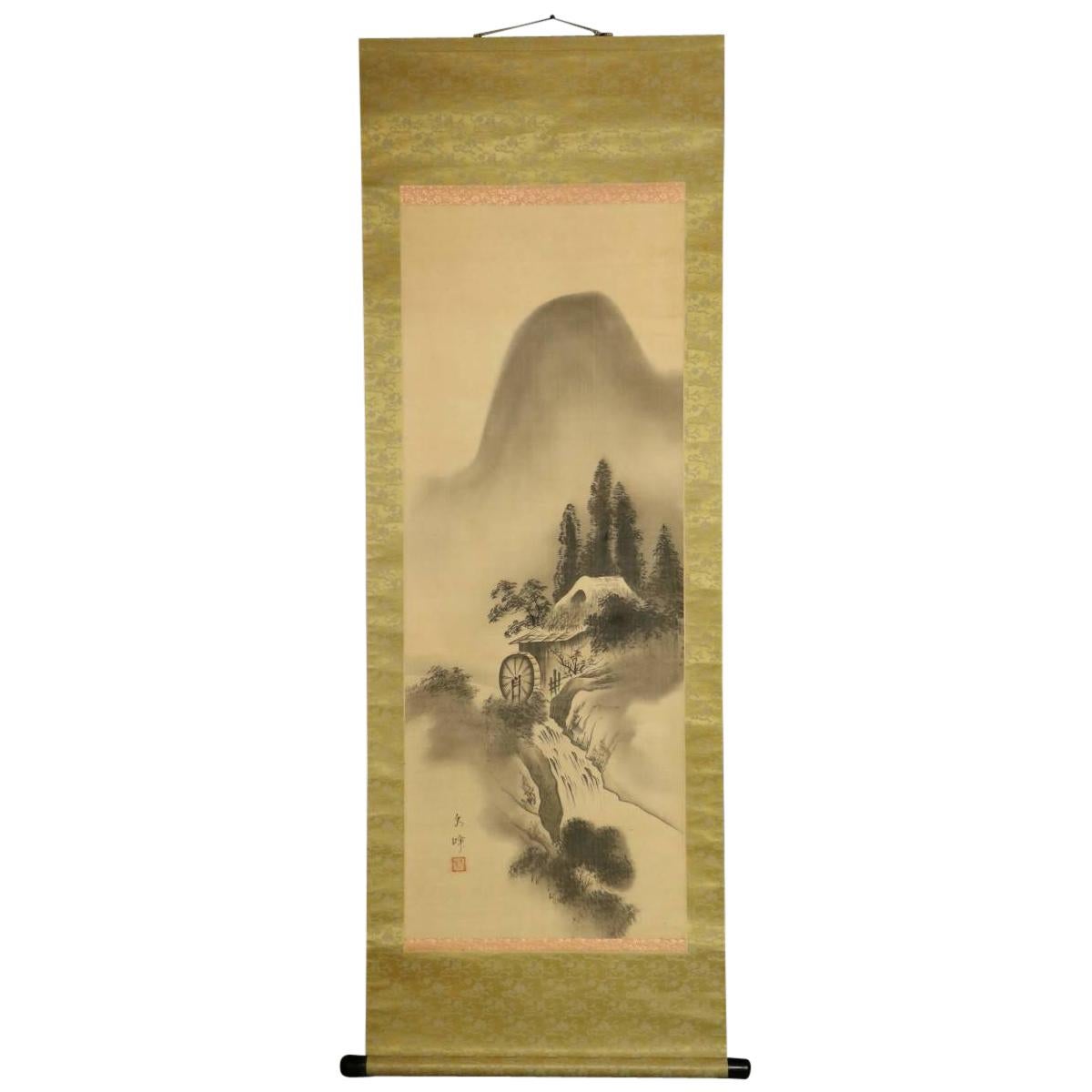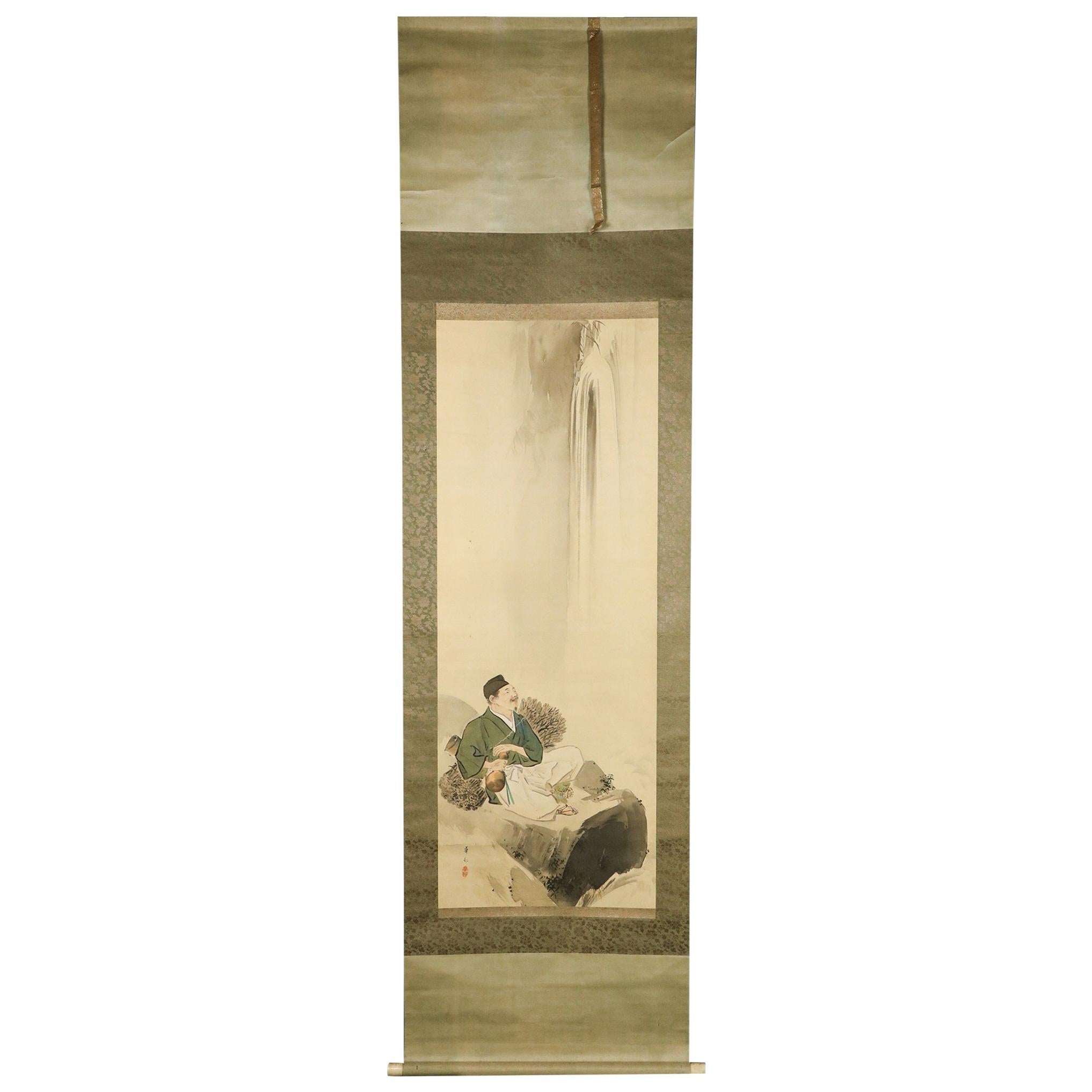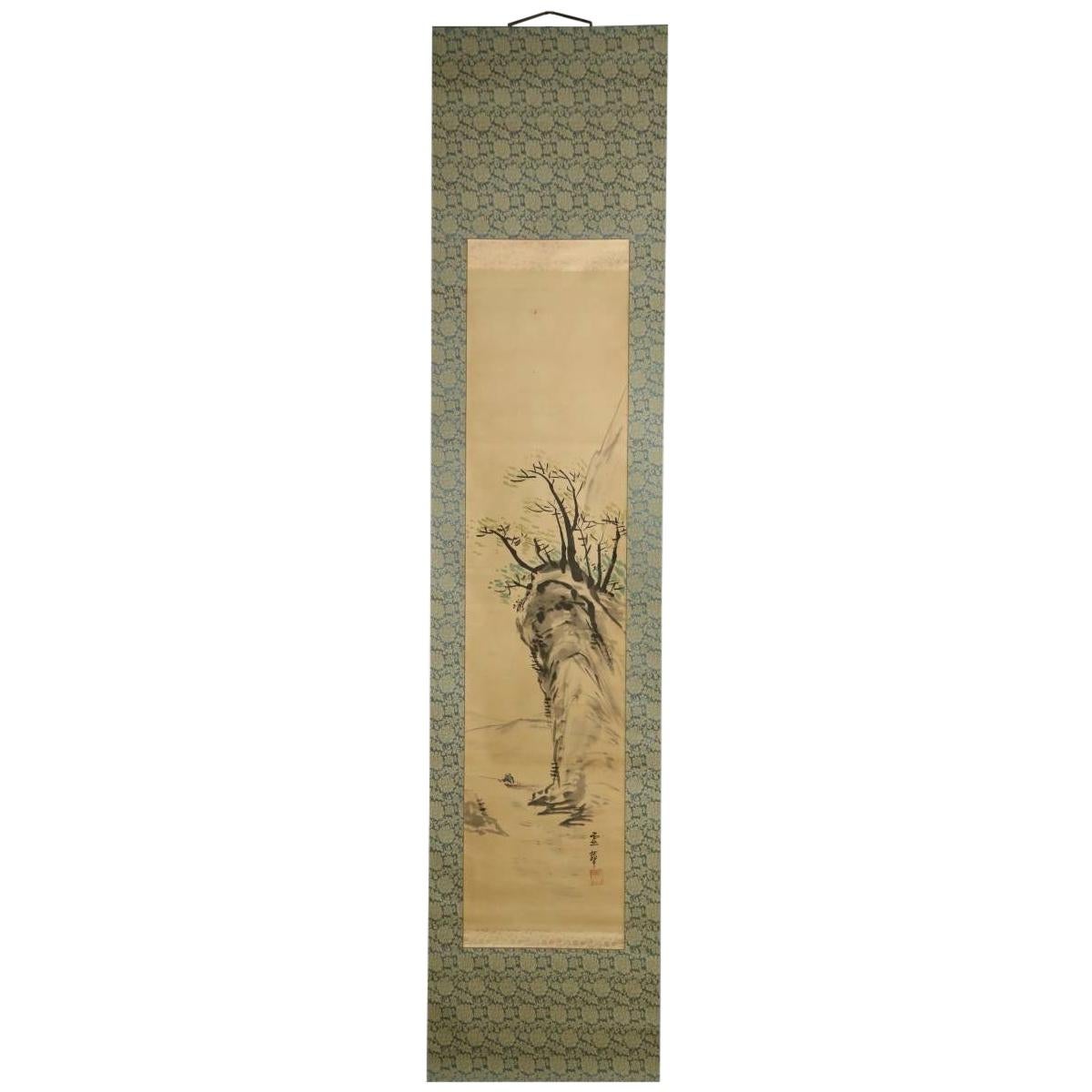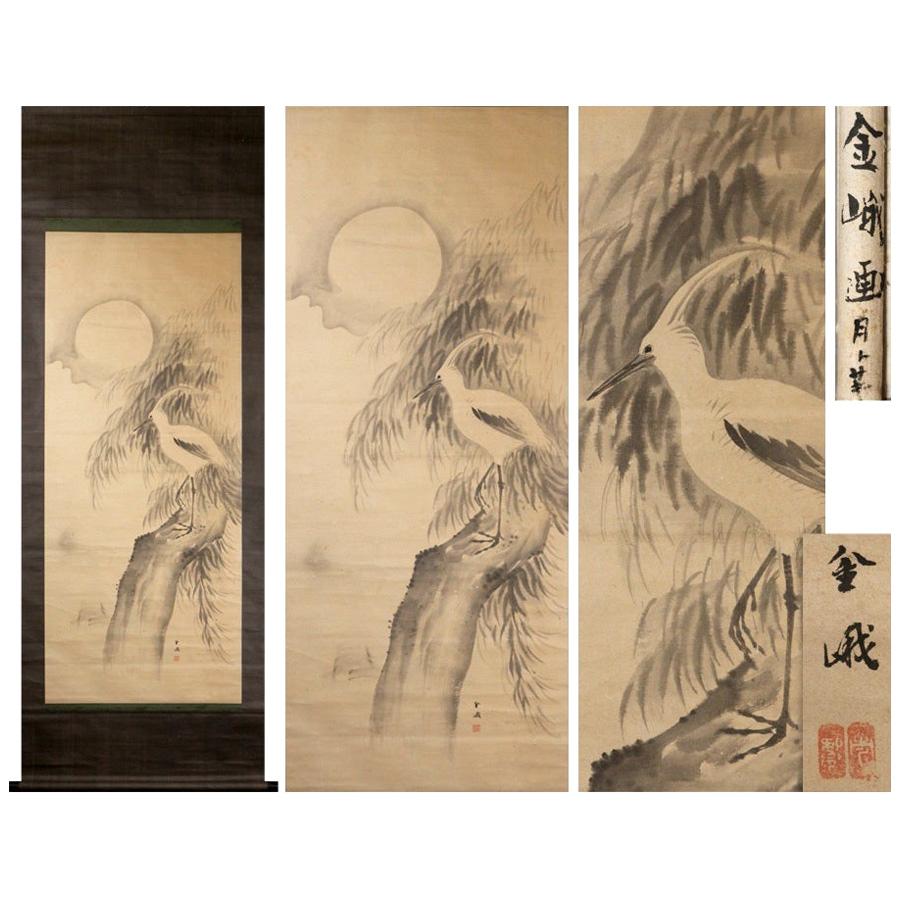Items Similar to Lovely Meiji Period Scroll Paintings Japan Meiji Artist Fuko Matsumoto
Want more images or videos?
Request additional images or videos from the seller
1 of 9
Lovely Meiji Period Scroll Paintings Japan Meiji Artist Fuko Matsumoto
About the Item
Fuko Matsumoto, order of the rising sun,
Size: Axis, vertical 212.5 cm next to 84.7 cm
Painting, vertical 140.8 cm horizontal 66.7cm ? Differs slightly in size.
Condition: The state is good, but, wrinkle-thin stain
Biography Fuko Matsumoto 1840-1923
Japan painter. Ibaraki prefecture production. Imperial Art Academy member.
Fuko was born as the 3rd son of Matsumoto Soan in Kawachi County of Hitachi Province (Now Inashiki City of Ibaraki Prefecture) on September 14 of the 11th year of the Tenpo era.
His real given name was Toshiro.
In 1853, when Fuko was 14 years old, he went to Edo and studied painting under Oki Ichiga, who was an official painter of Tottori Domain.
Ichiga was a painter who studied the Kano, the Rinpa and the Nanpin styles, and was good at expressing flowers & birds in deep colors.
Later, Fuko studied painting under Satake Eikai, who was best pupil of Tani Buncho, and, who was an official painter of Hikone Domain.
In addition, Fuko became a disciple of Kikuchi Yosai who was an official painter of the Tokugawa Shogunate.
Yosai was the leading painter of historical pictures at that time.
After the Meiji Restoration (1868), Fuko participated in establishing the Japan Art Institute (Nihon Bijutsu-In) in 1898.
And he adjudicated the Bunten Exhibitions from the first holding to the 4th.
Fuko was good at painting historical pictures as same as his master Kikuchi Yosai.
Fuko exhibited his works to the 1st Bunten Exhibition, the 4th Naikoku Kangyo Hakurankai Exhibition and others.
In 1919, he became a member of the Imperial Art Academy (Teikoku Bijutsu-In).
Fuko also established his private school "Angado-Gajuku" at home.
He cultivated a lot of famous pupils such as Imamura Shiko, Hayami Gyoshu, Shimazaki Ryuu, Kamoshita Choko, Takahashi Koko, Omoda Seiju, Iwai Shozan, Matsumoto Ryoko (Fuko's 4th son) and Nakajima Kiyoyuki.
Fuko passed away on June 22 of 1923 at the age of 84.
- Dimensions:Height: 83.67 in (212.5 cm)Width: 33.35 in (84.7 cm)Depth: 0.04 in (1 mm)
- Style:Meiji (Of the Period)
- Materials and Techniques:
- Place of Origin:
- Period:
- Date of Manufacture:19th Century
- Condition:Wear consistent with age and use. Size Axis ... vertical 212.5cm next to 84.7cm Painting ... vertical 140.8cm horizontal 66.7cm Condition: The state is good, but, wrinkle-thin stain.
- Seller Location:Amsterdam, NL
- Reference Number:
About the Seller
5.0
Gold Seller
These expertly vetted sellers are highly rated and consistently exceed customer expectations.
Established in 2015
1stDibs seller since 2019
158 sales on 1stDibs
Typical response time: 11 hours
- ShippingRetrieving quote...Ships From: Amsterdam, Netherlands
- Return PolicyA return for this item may be initiated within 14 days of delivery.
More From This SellerView All
- Lovely Meiji Period Scroll Paintings Japan Artist Landscape PaintedLocated in Amsterdam, Noord HollandHanging scroll calligraphy "mountains" silk color Zaimei (Baiyun Sang-jin) both box Size Axis ... vertical 196cm horizontal 50.5cm in ... vertical 126cm horizontal 37.5cm.Category
Antique 19th Century Japanese Meiji Paintings and Screens
MaterialsSilk
- Lovely Nihonga Scene Meiji/Taisho Period Scroll Japan Artist PaintingLocated in Amsterdam, Noord HollandLovely Nihonga scene Meiji/Taisho period scroll Japan artist painting. Painting size: (Width x height) mm 525 x 1499.Category
Antique 19th Century Japanese Meiji Paintings and Screens
MaterialsSilk
- Lovely Nihonga Scene Meiji/Taisho Period Scroll Japan Artist Suzuki KasonLocated in Amsterdam, Noord HollandAlso known as Suzuki Kason (????) primary name: Suzuki Kason Details individual; painter/draughtsman; Japanese; Male Life dates 1860-1919 Biography Painter. Suzu...Category
Antique 19th Century Japanese Meiji Paintings and Screens
MaterialsSilk
- Lovely Nihonga Scene Meiji/Taisho Period Scroll Japan Artist Reika YoshikawaLocated in Amsterdam, Noord HollandReika Yoshikawa (Reika Yoshikawa, Meiji eight years (1875) May 4 days-Showa 4 years (1929) March 25), the Meiji Taisho era Japan painter. His real name is Hitoshi, commonly known as Saburo. Yamato-e basic widely while the oriental of classical learning in art, line drawing, especially in Seiga paintings representation by taking advantage of beautiful thin line, such as flow, "draw" from "null" to the center of gravity is going modern...Category
Antique 19th Century Japanese Meiji Paintings and Screens
MaterialsSilk
- Lovely Nihonga Scene Meiji/Edo Period Scroll Japan Artist Furuichi KintomeLocated in Amsterdam, Noord HollandIt is a work drawn by Furuichi Kintomi as you can see. In addition to the fantastic depth of willow under the moon, the Egret that shines in the night view is a truly delicious pie...Category
Antique 19th Century Japanese Meiji Paintings and Screens
MaterialsSilk
- Lovely Nihonga Scene Meiji/Taisho Period Scroll Japan Artist Landscape BoatsLocated in Amsterdam, Noord HollandAxis: Vertical 192 cm, Horizontal 38.3 cm Inside: Vertical 130 cm, Horizontal 35 cm *Some errors will occur in the dimensions. Please understand. I don't know the details of the au...Category
Antique 19th Century Japanese Meiji Paintings and Screens
MaterialsSilk
You May Also Like
- Japan Scroll Painting, Meiji PeriodLocated in Pasadena, CAThis is a wonderful example of a Meiji Period screen painting of Japanese Tanuki or racoon dogs in a landscape. The Tanuki is considered to be a mythical creature Japanese culture. T...Category
Antique Late 19th Century Japanese Meiji Paintings and Screens
MaterialsFabric, Paint
- Japanese Meiji Riverside Scroll Painting, c. 1900Located in Chicago, ILAlthough western painting was initially embraced during Japan’s Meiji period (1868-1912), artists brought on a revival of traditional painting styles as they sought to create a modern Japanese style with roots in the past. This exquisite hanging scroll demonstrates the preference for soft layering of gray tones with judicious use of color. The landscape is rendered in soft ink washes that subtly distinguish between water, mountain, and sky. The scroll painting...Category
Early 20th Century Japanese Meiji Paintings and Screens
MaterialsPaper
- Japanese Gohonzon Buddhist Calligraphy Mandala Scroll Meiji PeriodLocated in Atlanta, GAA Japanese sumi ink calligraphy Buddhist mandala mounted as a paper hanging scroll known as Kakejiku or sometimes Moji mandala. Termed as gohonzon in Japanese, it is a venerated object within Nichiren Buddhism (Hokkeshu; lotus sect). The originally concept was developed by the 13th century Buddhist priest Nichiren to guide the energy of the devotional chanting to...Category
Antique Early 1900s Japanese Meiji Paintings and Screens
MaterialsPaper
- Japanese Gohonzon Buddhist Calligraphy Mandala Scroll Meiji PeriodLocated in Atlanta, GAA Japanese sumi ink calligraphy Buddhist mandala mounted as a paper hanging scroll known as Kakejiku or sometimes Moji mandala. Termed as gohonzon in Japanese, it is a venerated object within Nichiren Buddhism (Hokkeshu; lotus sect). The originally concept was developed by the 13th century Buddhist priest Nichiren to guide the energy of the devotional chanting to...Category
Antique 1890s Japanese Meiji Paintings and Screens
MaterialsPaper
- Antique hanging scroll of Japanese cat/Late Edo-Meiji period/Cat paintingLocated in Sammu-shi, ChibaThis is a picture of a cat drawn by a person named "Toshizumi Nitta" from the end of the Edo period to the beginning of the Meiji period. She is a very simple and cute cat. He is a vassal of the Tokugawa Shogunate, born in Ota City, Gunma Prefecture (southern part of Gunma Prefecture). He was related to the Tokugawa family and lived in a large mansion in the Ota clan in Gunma prefecture. However, the Nitta family's territory was very small, and they were by no means a wealthy vassal. He seems to have lived quite poorly. So he painted cats and sold them to people. The Nitta family continued to draw pictures of this cat for four generations. "Nitta toshizumi" is equivalent to the fourth generation. During the Edo period, sericulture was thriving in the Kanto region. Cats were said to be the gods of silkworms, as they drive away mice, the natural enemies of silkworms. It was the Nitta family who drew such a cat on paper, pasted it in the silkworm chamber, and sold it as a mouse repellent. There were also other monks who painted pictures of cats, but the Nitta family in particular was related to the Tokugawa family, so people believed that paintings of cats had special powers. , a lot of paintings...Category
Antique Late 19th Century Japanese Edo Paintings
MaterialsPaper
- Japanese Meiji Hanging Scroll of Ayu Fish, c. 1850Located in Chicago, ILAlthough Western painting was initially embraced during Japan’s Meiji period (1868–1912), artists brought on a revival of traditional painting styles as they sought to create a moder...Category
Antique Mid-19th Century Japanese Meiji Paintings and Screens
MaterialsPaper, Silk
Recently Viewed
View AllMore Ways To Browse
Japanese Fabric
Japanese Late Meiji
Fabrics From Japan
Asian Art Scrolls
Japanese Painting 19th
19th Century Japanese Paintings
Lovely Bird
Japanese Fabric Art
Scrolls Japan
Japanese Scroll
Japanese Bird Painting
Antique Japanese Scrolls
Japanese Antique Scroll
Japanese Antique Scrolls
Horizontal Japanese
Asian Paintings Of Birds
Japanese Scroll Art
Horizontal Scroll





